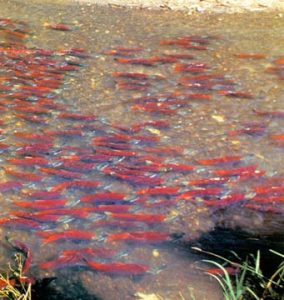
Chinook history involved making baskets (University of Washington – cedar root basket)
When did Native people come to the Pacific Northwest?
People have lived in the Pacific Northwest since the Paleo-Indian period, about 11,000 BC. They might even have arrived as early as 20,000 BC!
More about Paleo-Indians
History of fishing
All our Native American articles
What did early Natives live on?
Those first people were fishers. They may have been following the coastline, where the mussels and clams were. They also probably gathered lots of plants, berries, nuts and seeds to eat. Sometimes they also hunted big animals like mammoths with their spears and atlatls. There were plenty of big animals while the Ice Age was just ending.
Early Archaic in the Pacific Northwest
In this area, the Archaic period began around 7000 BC (a little later than in the south). Big animals like mammoth died out about this time. Hunters had to hunt smaller animals like deer and elk. They learned to fish for salmon in the rivers. The weather got warmer and some families dug wells to get water. People wove mats and baskets and fishing nets and sandals.
History of baskets
What are atlatls?
The Archaic period
When did Native Chinook people arrive?
About 2000 BC (again a little later than in the south), the people of the Pacific Northwest entered the Middle Archaic. They still used spears and atlatls for hunting. But, like other Middle Archaic people further south, they began to feel a little more crowded on their land. So they started fishing more and gathering more of their food.
By about 1500 or 1000 BC, people also began to use fire to make more food for themselves. They set grass fires or forest fires on purpose to clear out weeds and underbrush. That made more room for animals they hunted and the plants they wanted to gather. By the end of the Middle Archaic period, around 300 BC, the Chinook people had moved into this area and settled down.
Late Archaic Chinook

Chinook history: Salmon “running” in the river
In the Late Archaic period after 300 BC, the Chinook lived along the Columbia and Willamette rivers. That’s near the Pacific coast in modern Oregon and Washington. They were hunters and gatherers, and especially fishers.
Bows and arrows
By this time, Chinook people lived mainly on salmon that they caught in the river during the spring salmon runs. They dried and smoked the salmon so they could keep it all winter. People also hunted elk and deer, using their new bows and arrows as well as their old spears and atlatls.
They gathered and ate acorns, and a lot of camas and wapato. Wapato grew in wetlands. It was a root like potatoes or yuca. Camas is a different root, more like onions.
What was Chinook government like?
The Chinook did not have inherited or elected leaders, but lived in small bands with only temporary leaders or “big men“. They traded along the Columbia and Willamette rivers and down the Snake River.
What were Chinook houses like?
Chinook people lived in villages on the high land above the rivers. Their houses were wooden longhouses built of cedar planks. Richer people had bigger houses, and poorer people had smaller ones. But if you were really poor you had to live in somebody else’s house. Big houses might have as many as a hundred people living in them.
More Native architecture
Each family within the house had a separate room with walls of woven mats, and a fire inside the room. But there was also a big fire in the middle of the hall that everyone could meet around.
This arrangement was a lot like the way British or Scandinavian people lived at the same time (as in Beowulf for instance), and also like the way the Iroquois and the Guarani lived – that is, it was appropriate for a community with cold winters and plenty of wood.
What did Chinook people look like?
Chinook people looked different from their neighbors, like the Nez Perce. That’s because the Chinook flattened the heads of their babies to make them look more beautiful. When a baby was little and her skull was soft, her mother took a wooden board and tied it to her baby’s head to flatten her forehead.
More about the Nez Perce
People thought this made their children more beautiful (or handsome, because mothers flattened boys’ heads too). It’s kind of the same way people use braces on teeth today, or pierced ears.
Instead of moving into the Woodland period, the Chinook stayed with the Late Archaic way of doing things until they began to be influenced by European traders.
Learn by Doing – Basketmaking
Chinook food
Later Chinook people
Bibliography and further reading about Chinook history: